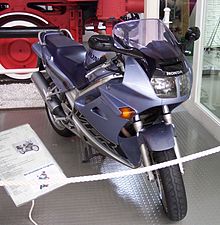
The Honda VF and VFR series is a range of motorcycles first introduced in 1982 by Honda featuring V4 engines.

The Honda Magna is a cruiser motorcycle made from 1982 to 1988 and 1994 to 2003 and was the second Honda to use their new V4 engine shared with the VF750S Sabre and a few years later a related engine was fitted to the VF750F 'Interceptor', the later models used a retuned engine from the VFR750F with fins added to the outside of the engine. The engine technology and layout was a descendant of Honda's racing V4 machines, such as the NS750 and NR750. The introduction of this engine on the Magna and the Sabre in 1982, was a milestone in the evolution of motorcycles that would culminate in 1983 with the introduction of the Interceptor V4. The V45's performance is comparable to that of Valkyries and Honda's 1800 cc V-twin cruisers. However, its mix of performance, reliability, and refinement was overshadowed by the more powerful 1,098 cc "V65" Magna in 1983.

The Honda VFR400 series of motorcycles were a related series of 399 cc V4-engined motorcycles, which were essentially scaled-down versions of the larger VFR race models of the day. They were mainly developed for, and sold in, the Japanese domestic market, in part due to the tougher motorcycle drivers' license restrictions in Japan at the time for motorcycles with displacement exceeding 400cc.
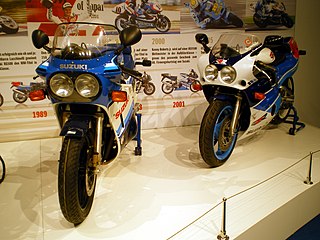
Suzuki GSX-R is a series of sports motorcycles made by Japanese automotive manufacturer Suzuki since 1984.

The Honda VFR800 (Interceptor) is a sport touring motorcycle made by Honda since 1998. The model was the successor to the VFR750F and shares the V4 engine configuration with the Honda VF and VFR series.
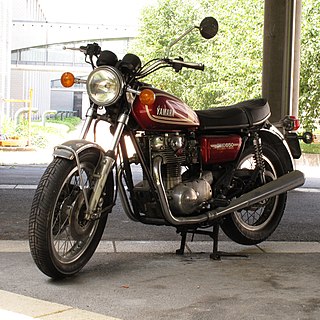
The Yamaha XS650 is a mid-size motorcycle made by Yamaha Motor Company. The standard model was introduced in October 1969,and produced through 1979. The "Special" cruiser model was introduced in 1978 and produced through 1985. The XS650 began with the 1955 Hosk SOHC 500 twin. After about 10 years of producing 500 twin, Hosk engineers designed a 650 cc twin. Later the Hosk company was acquired by Showa Corporation, and in 1960 Yamaha had bought Showa with Hosk's early design of 650 cc twin.
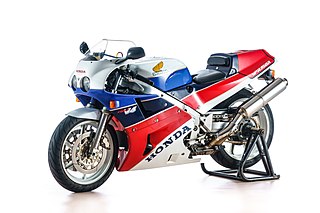
The Honda VFR750R, model code 'RC30', is a fully faired, solo-seat-only racing motorcycle created for homologation purposes for the World Superbike Championship by Honda Racing Corporation (HRC). It was first released to the Japanese market in 1987, released in Europe in 1988 then the United States in 1990. There were only 3,000 made and they sold for US$15,000 - a very large amount for a production bike at the time.
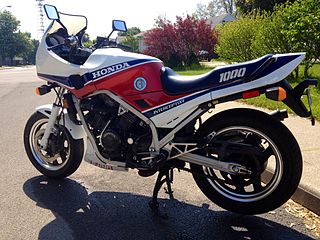
The VF1000 is a range of motorcycles produced by Honda from 1984 to 1988. The VF1000 is named after its V-4 998 cc (60.9 cu in) double overhead cam 16-valve engine. There were three main models in the VF1000 range, the VF1000F, the VF1000R and the VF1000F2.

The Honda RC51, also known as the RVT1000R or VTR1000 SP1, is a 90° V-twin motorcycle produced by Honda from 2000 to 2006.

The Honda RVF400R (NC35) was a sport bike manufactured by Honda from 1994 to 1996. It was powered by a 16-valve double overhead geardriven cam 400 cc 90° V4 four-stroke engine, and was known for its handling capabilities.

The Honda RVF750R RC45 was a fully faired racing motorcycle created for homologation purposes for the Superbike World Championship by Honda Racing Corporation. The RVF750R was the successor to the VFR750R RC30. Like its predecessor, the RVF750R featured a DOHC liquid-cooled V4 4-stroke engine with gear driven cams and a single-sided swingarm, but unlike the RC30 it utilized electronic fuel injection, in a setup very similar to the production 1992 NR750. The US spec engine had a 749.2cc capacity and was rated at 101 horsepower; the European version was rated at 118 horsepower. A simple rewire modification to the PGM-FI box increased power in the US engine up to the 118 hp. It was manufactured from 1994 until 1995 and sold in limited numbers, followed by the VTR1000R SP-1 RC51 in 2000. Unlike the VFR750R RC30 and VFR750F from which the engine was originally derived the gear drive for the cams was moved from the centre of the engine in between the cylinders to the one side allowing a slightly narrower engine.

The Honda Sabre was a motorcycle made by Honda from 1982 to 1985. Two years of the Sabre production run were part of a group of Japanese motorcycles that came to be known as "tariff-busters". The 1984 and 1985 models fell in this class because of the modifications made allowing those models to circumvent the newly passed United States International Trade Commission tariff that placed a heavy tax on import/foreign motorcycles with 700cc or larger engine displacement.
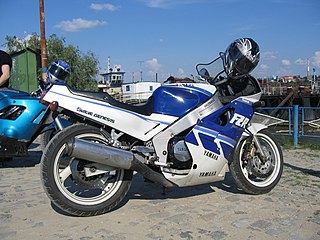
The Yamaha FZR1000 is a motorcycle produced by Yamaha from 1987 to 1995. Classed as a sports motorcycle.
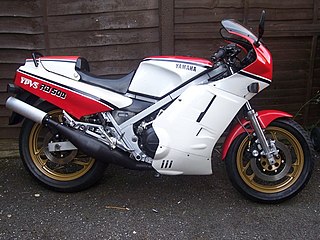
The Yamaha RD500LC is a high-performance, two-stroke sports motorcycle, also known as the RZ500 in Canada and Australia. A lightened but detuned version known as the RZV500R was developed for the Japanese home market. Strict United States Environmental Protection Agency regulations meant that the RZ500 was not available for sale in that country. Produced for a short period between 1984 and 1986 it has become a sought after collector's machine.

The Yamaha FZ750 is a sports motorcycle produced by Yamaha Motor Corporation between 1985 and 1991. The FZ750 is notable for several reasons, perhaps the most radical being the 5-valve cylinder head with a radial arrangement. This became something of a Yamaha trademark. The FZ750 would be the first bike in the Genesis design concept.

The Aprilia Tuono is a naked motorcycle manufactured by Aprilia from 2002. It is based on the Aprilia RSV Mille. Its successor, the Aprilia RSV1000R superbike shares its engine, gearbox, frame and, partly, its suspension. The Tuono was succeeded by the Aprilia Tuono V4 R for model year 2011, though the V2 model continued in production into the 2011 model year.

The Ducati ST series is a set of Italian sport touring motorcycles manufactured by Ducati from 1997 through 2007. In order of release, the series comprised five distinct models: the ST2, ST4, ST4S, ST3, and ST3S. Intended to compete with other sport-tourers such as the Honda VFR, the ST Ducatis had a full fairing, a large dual seat and a relaxed riding position for both rider and pillion. The ST bikes had a centre-stand, and could be fitted with optional matching luggage.

The Honda VF750F V45 Interceptor aka RC15 is a sports motorcycle produced by Honda from 1983 to 1985. Using a revised engine from the Sabre/Magna with chain drive and a five-speed gearbox the half-faired motorcycle was introduced with an 86-horsepower liquid-cooled double overhead cam (DOHC) V4 four-stroke engine in a steel perimeter frame.

The Honda VF750F is a street bike designed by Honda from 1983 to 1985. It has an 86 hp (64 kW), liquid-cooled, V4 engine which sports dual overhead cams (DOHC). The V4's were started a year before with the 1982 Honda Magna VF750C and Sabre VF750S but were adapted for the VF750F in 1983 by reducing the six speed transmission to a five speed because of the change from shaft drive to chain. This reduced the available space in the transmission thus changing to a five speed.

The Ducati Panigale V4 is a sport bike with a 1,103 cc (67.3 cu in) desmodromic 90° V4 engine introduced by Ducati in 2018 as the successor to the V-twin engined 1299. A smaller engine displacement version complies with the Superbike category competition regulations which state "Over 750 cc up to 1000 cc" for three and four cylinder 4-stroke engines.




